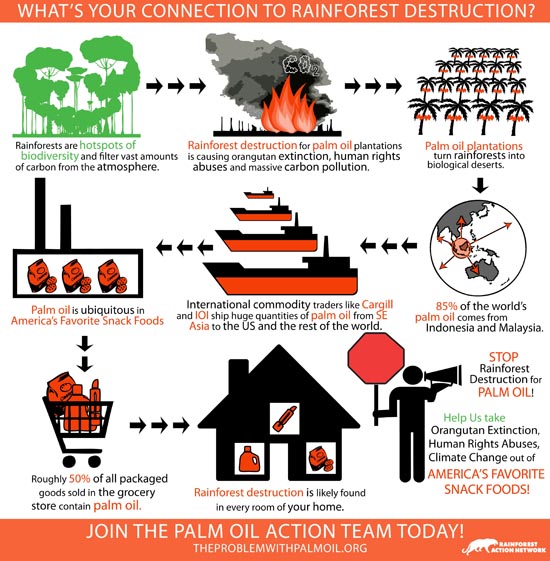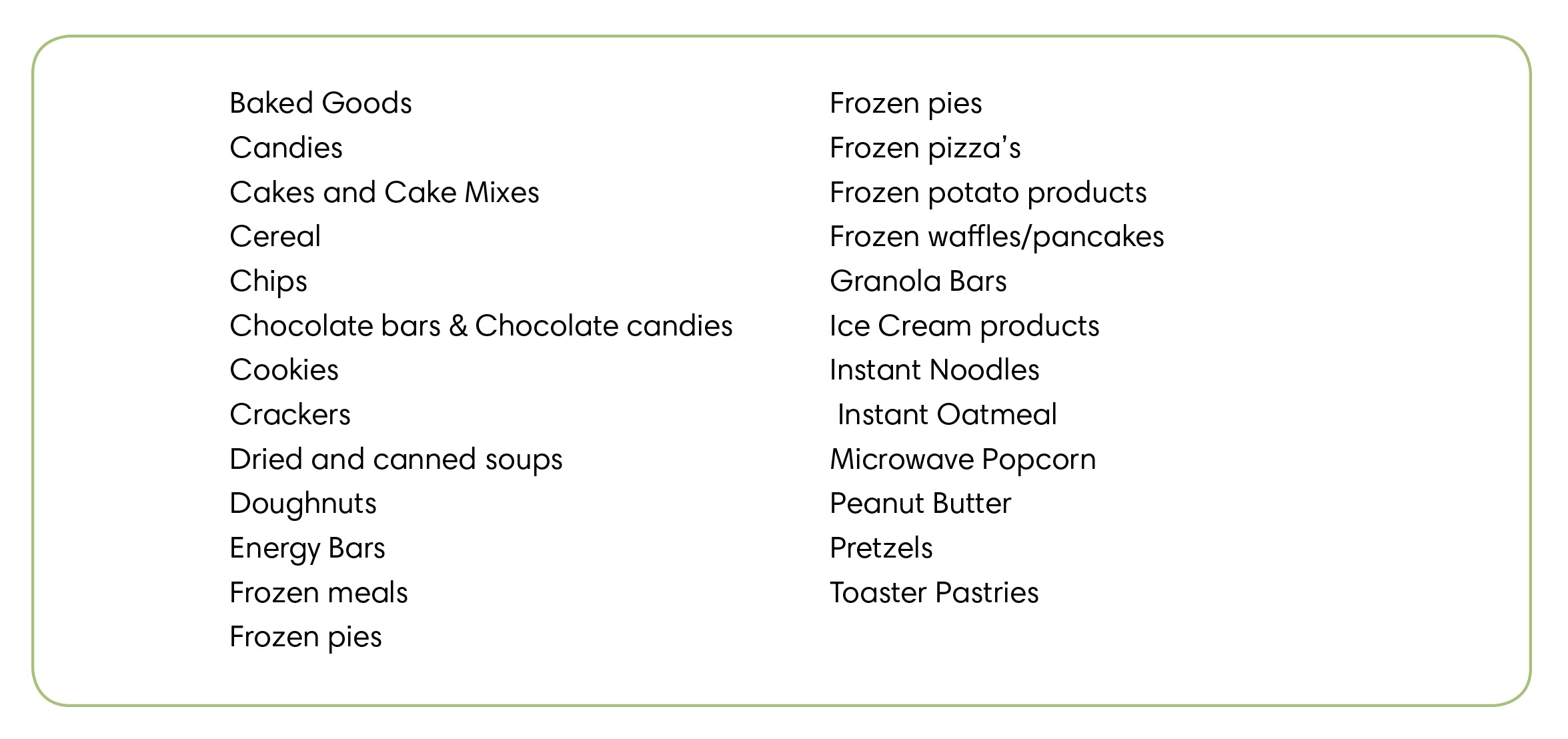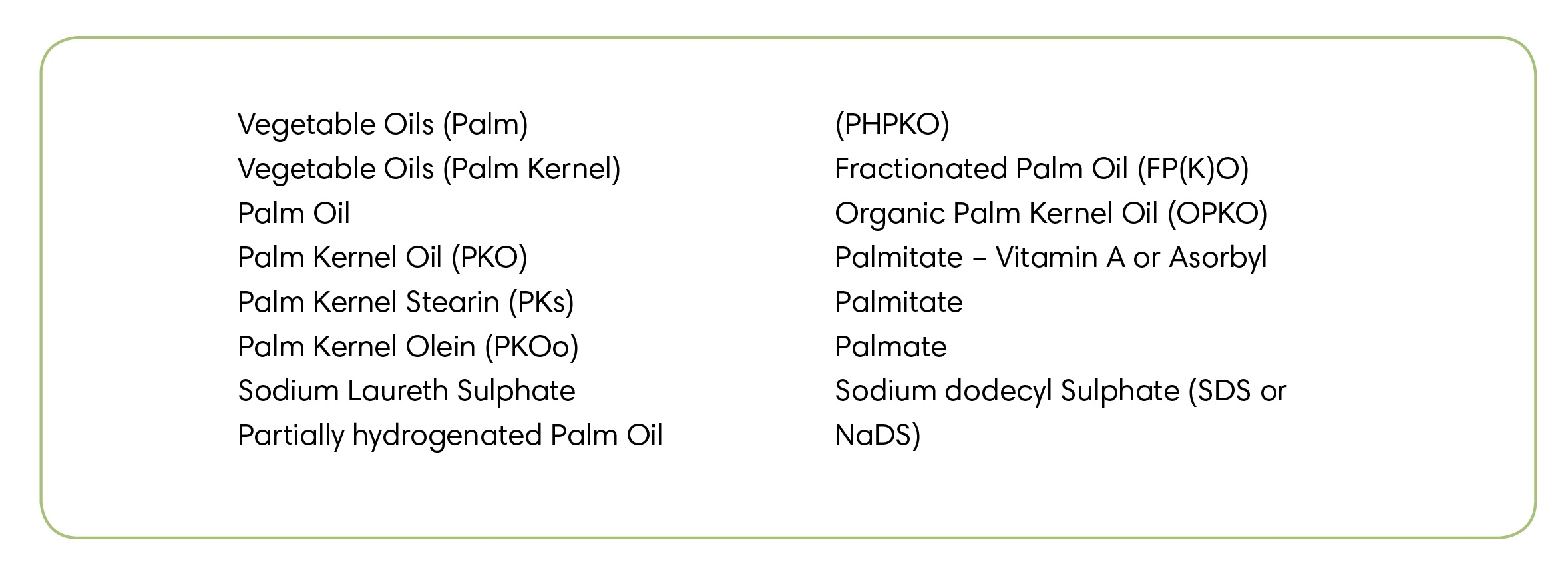Palm oil touches our lives every time we take a trip to the supermarket. Palm oil and its derivatives are used in a ubiquitous array of packaged foods, including ice cream, cookies, crackers, chocolate products, cereals, breakfast bars, cake mixes, doughnuts, potato chips, instant noodles, frozen sweets and meals, baby formula, margarine, and dry and canned soups.
In the U.S. alone, palm oil imports by companies like Cargill and IOI have jumped 485% in the last decade. The dramatic and growing demand for this crop in recent decades has pushed sprawling palm oil plantations deep into some of the world’s most valuable rainforests. Palm oil production is now one of the leading causes of rainforest destruction around the globe.
What’s your connection to rainforest destruction? We put together this graphic to help explain how palm oil tied to deforestation in Indonesia has become so ubiquitous, and what you can do to help solve the problem. It’s incredibly important that we spread the word—share this graphic on Facebook, on Twitter, or download a printable PDF now!
Click image for full size.
Rainforest Destruction by Palm Oil
Nearly 90% percent of palm oil is grown in the tropical countries of Indonesia and Malaysia, where palm oil plantations under active cultivation cover 16 million acres, an area similar in size to West Virginia. The Indonesian government has announced plans to convert approximately 44 million more acres of rainforests, an area the size of Missouri, into palm oil plantations by 2020. The UN’s Environment Program says that “98% of Indonesia’s forest may be destroyed by 2022, the lowland forest much sooner.”
The worst part: This problem is not confined to Indonesia. Rainforest destruction for palm oil expansion is spreading quickly to other valuable rainforest regions, such as Central Africa. That’s one of many reasons why it’s so important that we tackle this problem now. Below are several others, all of which we’ve collected into this “Case Against Palm Oil” factsheet (PDF).
Endangered species and the loss of biodiversity
Download the “Case Against Palm Oil” factsheet.
Indonesia’s rainforests are one of Earth’s most biologically and culturally rich landscapes. Incredibly, with just 1 percent of the Earth’s land area, Indonesia’s rainforests contain 10% of the world’s known plants, 12% of mammals and 17% of all known bird species. As recently as the 1960s, about 80% of Indonesia was forested. Sadly, Indonesia now has one of the highest deforestation rates in the world, with just under half of the country’s original forest cover remaining. Conservative studies suggest more than 2.4 million acres of Indonesian rainforest is cleared and lost each year.
The rainforests of Borneo and Sumatra are the last stand for one of humankind’s closest relatives, the orangutan. Orangutans face an extreme risk of extinction within our lifetime. Between 2004-08, the Sumatran orangutan population fell by 14% to 6,600, largely due to loss of habitat for palm oil expansion. The critically endangered Sumatran tiger and Sumatran rhinoceros, both of which have populations of only hundreds left in the wild, are also urgently threatened by palm oil expansion.
Forest communities and human rights
Corporate land grabbing of Indigenous and community forests for palm oil plantations is responsible for serious human rights abuses and persistent conflicts between companies and rural communities. In Indonesia there are over 500 different language groups and between 60 and 110 million Indigenous peoples, many of whom depend on standing natural forests for their livelihoods.
The Indonesian palm oil monitoring group Sawit Watch has identified 663 ongoing land disputes between palm oil companies and rural communities. In too many cases, private armies and paramilitaries have been deployed and people have been killed. Many industrial palm oil plantations also rely on the use of forced and child labor. In Malaysia and Indonesia, child labor has been documented and allegations of modern-day slavery on plantations across Malaysia are common.
Peatlands and climate change
Peatlands are carbon-rich wet ecosystems that have sequestered billions of tons of carbon through thousands of years of accumulating leaf litter and organic material. Indonesia has the world’s highest concentration of tropical peatlands, but the scale of their destruction is so large that it is having globally significant impacts on the climate, similar in scale to the world’s biggest coal and tar sands projects.
Indonesia is the world’s third largest emitter of greenhouse gases after the U.S. and China, with 85% of its emissions coming from rainforest and peatland destruction. Deforestation in Indonesia is responsible for some 5% of global greenhouse gas emissions, which is more than the combined emissions from all the millions of cars, trucks, trains, and buses in the U.S. each year combined.
The Solution: Responsible Palm Oil
Consumers are often misled by “RSPO-certified” or “Green Palm” labels. These labels from the Roundtable of Sustainable Palm Oil (RSPO) still allow “certified sustainable” palm oil producers to destroy rainforests and carbon-rich peatlands. Companies that produce, trade and use palm oil must go beyond these inadequate RSPO standards to be truly responsible.
Responsible palm oil is produced without contributing to rainforest or peatland destruction, species extinction, high greenhouse gas emissions or human rights violations. Snack food manufacturing companies need transparent and traceable supply chains from the plantation where the palm oil was sourced to the final product on your grocery store shelf.
- Join the Palm Oil Action Team and organize events in your community to help spread the word and call out the companies using palm oil tied to rainforest destruction in their products.
- Share this blog or blog about the problems with palm oil.
- Become more aware of the snack foods that contain palm oil and reduce your consumption of those products.
How To Identify Palm Oil Products Palm oil is found in roughly 50% of the products in grocery stores! Below is a list of some of the types of snack food products that contain palm oil to look out for when you’re shopping: 
Many snack foods are made using an array of ingredients derived from the African oil palm. It won’t always be obvious when palm oil is lurking under the wrapper, so to take out the guess work, we’ve made a list of the most common palm oil ingredients used in snack foods:
FOR MORE INFORMATION VISIT: THEPROBLEMWITHPALMOIL.ORG

